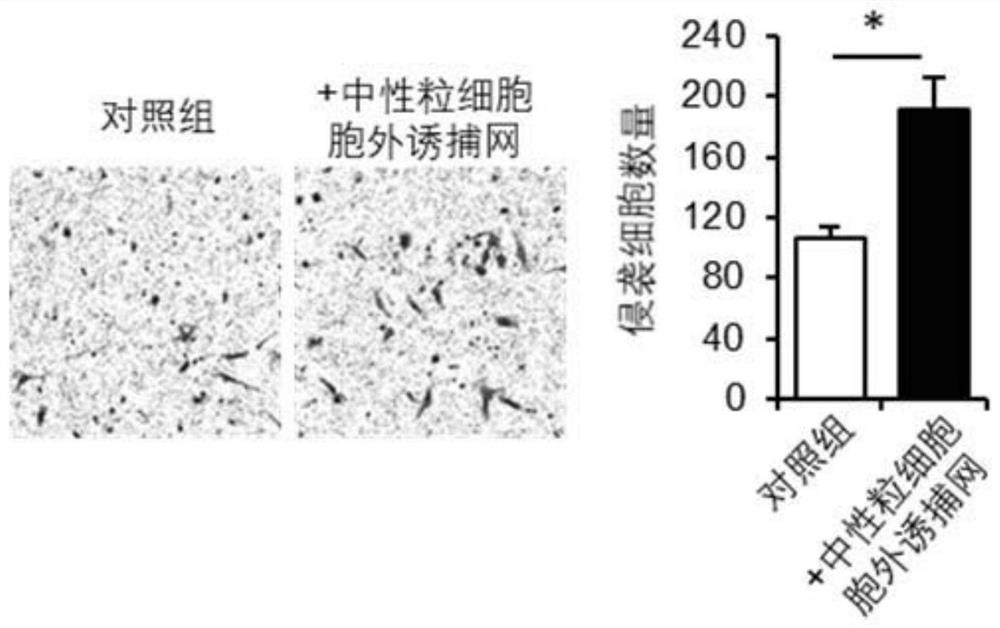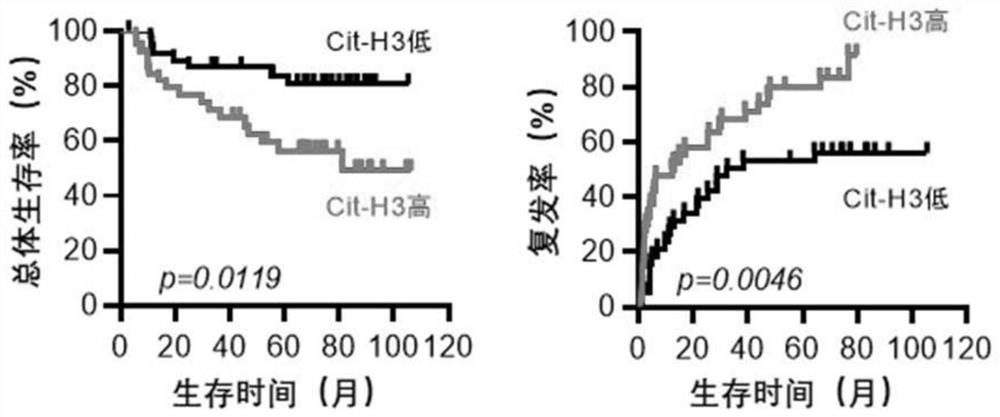Application of CIT-H3 protein detection reagent in preparation of liver cancer prognosis and/or recurrence prediction reagent
A CIT-H3, 1. CIT-H3 technology, applied in the field of life sciences, can solve the problems of high cost and technical threshold, low detection sensitivity of diagnosis and targeted drug screening markers, etc., and achieve the effect of easy operation
- Summary
- Abstract
- Description
- Claims
- Application Information
AI Technical Summary
Problems solved by technology
Method used
Image
Examples
Embodiment 1
[0027] Example 1 Neutrophils produce "neutrophil extracellular traps" to promote malignant progression of liver cancer
[0028] 1. Experimental method
[0029] In this implementation case, neutrophils were first isolated from the peripheral blood of healthy people, cultured in vitro by adding tumor cell culture supernatant, and neutrophil extracellular traps were induced and purified. Then use the Transwell chamber experiment, add purified neutrophil extracellular traps, and detect the changes in the invasion ability of the human liver cancer cell line HepG2 cells in the Transwell chamber, so as to evaluate the effect of neutrophil extracellular traps on the malignant progression of tumor cells influences.
[0030] 2. Experimental results
[0031] The result is as figure 1 As shown, compared with the control group, after adding the "neutrophil extracellular trap", the number of human liver cancer cells invading to the lower surface of the Transwell chamber increased, and th...
Embodiment 2
[0032] Example 2 A liver cancer patient's poor and recurrence rate prediction kit
[0033] In this example, CIT-H3 antigen was selected as a marker for the production of "neutrophil extracellular traps" in tumor tissues, and a kit for detecting its production level was established by using traditional immunohistochemical staining.
[0034] 1. Composition
[0035] The primary antibody CIT-H3 (purchased from Abcam, product number is ab5103) and the second anti-rabbit IgG antibody labeled with horseradish peroxidase (purchased from Dako company, product number is P044801-2).
[0036] 2. How to use
[0037] 1. Specimen detection
[0038] (1) Select a paraffin section of liver cancer that includes the tumor area, and ensure that there is no large area of necrosis;
[0039] (2) Obtain 8 paraffin sections of 4 μm, bake the slices at 60°C for 2 hours, take them out, and cool slightly;
[0040] (3) Dewaxing with xylene twice at room temperature, 10 minutes each time;
[0041] (4...
Embodiment 3
[0064] Example 3 The specific expression of CIT-H3 "neutrophil extracellular trap" is associated with poor prognosis and high recurrence rate of patients
[0065] 1. Experimental method
[0066] In this implementation case, 80 cases of liver cancer patients with surgically resected liver cancer samples and relevant clinical pathological information were collected, and the expression of CIT-H3 in the liver cancer tissues of these patients was detected by using the kit in implementation 2. After statistical analysis, combined with the prognosis and survival of the patients The data were analyzed by COX risk regression, and combined with pathological information such as recurrence, the chi-square correlation test was performed.
[0067] 2. Experimental results
[0068] The results showed that grouping by using the expression level of CIT-H3 can effectively predict the overall survival and recurrence time of patients, and there is a significant difference. (Overall survival P=0....
PUM
 Login to View More
Login to View More Abstract
Description
Claims
Application Information
 Login to View More
Login to View More - R&D
- Intellectual Property
- Life Sciences
- Materials
- Tech Scout
- Unparalleled Data Quality
- Higher Quality Content
- 60% Fewer Hallucinations
Browse by: Latest US Patents, China's latest patents, Technical Efficacy Thesaurus, Application Domain, Technology Topic, Popular Technical Reports.
© 2025 PatSnap. All rights reserved.Legal|Privacy policy|Modern Slavery Act Transparency Statement|Sitemap|About US| Contact US: help@patsnap.com



